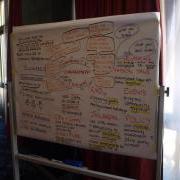Engaging Audiences, fostering community
Today’s Community Engagement Forum was a meeting of minds; a collection of representatives from stations all around Australia, where sharing experiences about engaging your community was the perogative.
Many of the session attendees agreed that getting people from their communities to participate by volunteering or providing local and relevant content was particularly difficult, as many were unsure of how to measure their influence.
It was agreed that community radio stations need to be more active in engaging their communities by hosting events and facilitating communication, rather than being passive.
It was also suggested that community radio stations need to consider the physical aspect of their stations in order to provide spaces, whether on-site or in the community, where people can contribute, hang out, and be educated at the same time.
Jonathan Brown, of SYN in Melbourne, discussed the importance of face-to-face communication and how stations can benefit from sharing values with their local communities.
“Shared passion for social change brings communities together” he said, “Community broadcasting is intrinsically linked to social change; we need to be proud of this”.
Rather than simply engaging with the community, stations should be seeking to create partnerships with their volunteers, listeners, and the wider local communities.
When connecting with youth audiences, particularly at small or rural stations, the focus needs to be on training and giving them the skills and independence they need to produce their own content, as well as helping them connect with older volunteers and presenters.
Facebook comments